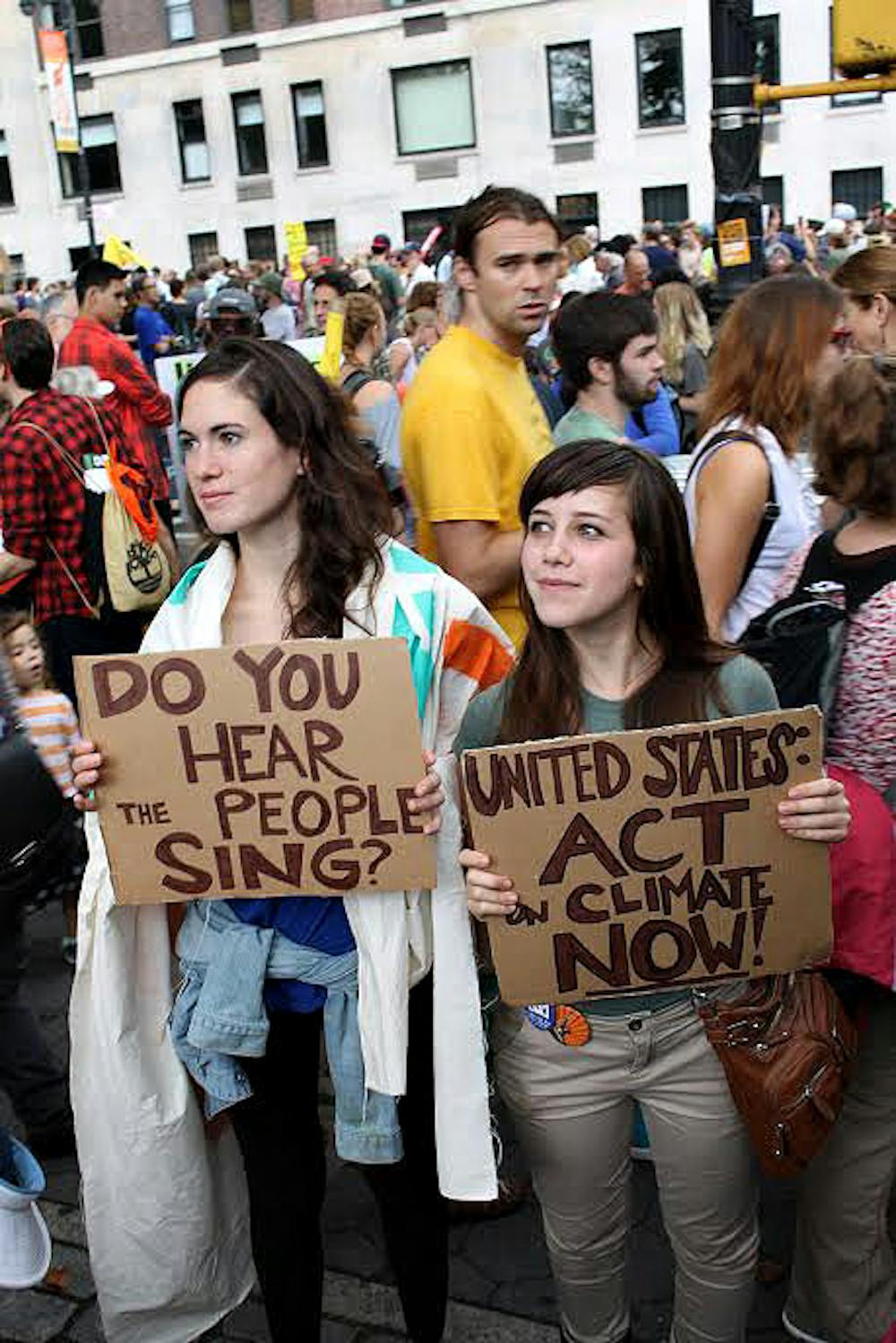Updated Monday, Sept. 22 at 11:45 p.m.
When Dawn King, visiting assistant professor of environmental studies, asked her class how many students were planning to attend this weekend’s People’s Climate March in New York, the response “inspired” her, she said.
Sixty percent of her class was planning to attend — an unprecedented level of student involvement in an environmental protest in her experience, she added.
The march was the largest in history. More than 400,000 marched in New York while nearly 3,000 simultaneous marches took place globally.
Hundreds of students from Brown, the Rhode Island School of Design and the University of Rhode Island, as well as residents from throughout the state, attended the march Sunday, which protested the destructiveness of climate change and urged politicians to take action against it. The bus tickets available from Providence and Kingston completely sold out, said Ruby Goldberg ’17, who was part of a small group of students who helped organize transportation to the march.
The atmosphere of the march was “incredible” with a sense of camaraderie among the numerous groups of people involved, said Marguerite Suozzo-Gole ’15.5.
The broad range of groups and people involved with the march shows that climate change is now seen as more than an environmental issue, said Professor of Sociology J. Timmons Roberts. It now concerns labor groups, religious organizations, businesses, students, families and beyond, he added. Roberts attended the march with his 11-year-old daughter.
Climate change’s deleterious effects are becoming more visible to the public, Suozzo-Gole said, and that visibility has garnered a wide range of activists. Environmental movements no longer solely involve environmental activists but also encompass other cross-sections of society, she added.
“This year there’s a sense of urgency given that average, on-the-ground citizens are starting to see the effects of climate change in their backyards,” she added.
The People’s Climate March coincides with the United Nations Climate Summit on Tuesday, where world leaders will discuss plans to combat climate change. U.N. Secretary General Ban Ki-moon, who also participated in the march, called the U.N. summit, which aims to raise global awareness of climate change.
Many activists hope this march will provide momentum going into the 2015 Climate Change Conference in Paris, where the U.N. will produce new climate legislation, Timmons said. One of the march’s primary goals was to put pressure on world leaders to write and implement legislation that curbs some of the factors causing climate change, such as carbon emissions, he added.
“Brown students are there to tell the world that this is an issue we have to take seriously, and world leaders will be there to hear it,” Timmons said.
The United States had virtually no organized climate change movements until the creation of 350.org in 2008, Timmons said. Previously, environmental activism groups were mostly dedicated to other issues, such as wilderness preservation. This weekend’s march symbolizes a major departure from the traditional environmental activism in that it is solely dedicated to climate change.
350.org, created by Bill McKibben P’16, has been a vital force in organizing some of the most significant movements over the past few years, including last year’s Keystone XL pipeline protest, Timmons said. The organization’s decentralized structure enables everyday people, especially students, to get involved and create their own agendas as well, he added.
“Issue framing” contributed a great deal to the march’s success, Timmons said, adding that the organizers downplayed environmental arguments and emphasized moral and economic arguments.
The march signifies a generational divide on environmental issues, King said. As the next crop of voters, today’s youth have taken on climate change full-throttle by dealing with it as a scientific issue, rather than a partisan matter, she added. Now that the public is largely convinced that climate change is a real phenomenon, the next step is to publicize viable solutions, she said.
Brown students are the optimal activists for the movement because they are interdisciplinary by nature, King said. Students attending the march understand all aspects of the problem, from environmental justice to the science behind climate change, she added.
This weekend’s march could be the “tipping point” in the movement against climate change, as it could make U.S. politicians understand the gravity of the situation, King said. College students could provide critical impetus at a time when the world is starting to see some of the worst effects of climate change, such as climate refugees, she added.
One of the most salient parts of the march was the moment of silence held for victims of climate change, said Suozzo-Gole. Following the silence, alarms and bells rang out in the city, symbolizing the ringing alarm for action on climate change, she added.
The student organizers of the buses to the march will hold a meeting this week to debrief about the protest and to discuss taking action in the future, Suozzo-Gole said.

ADVERTISEMENT




